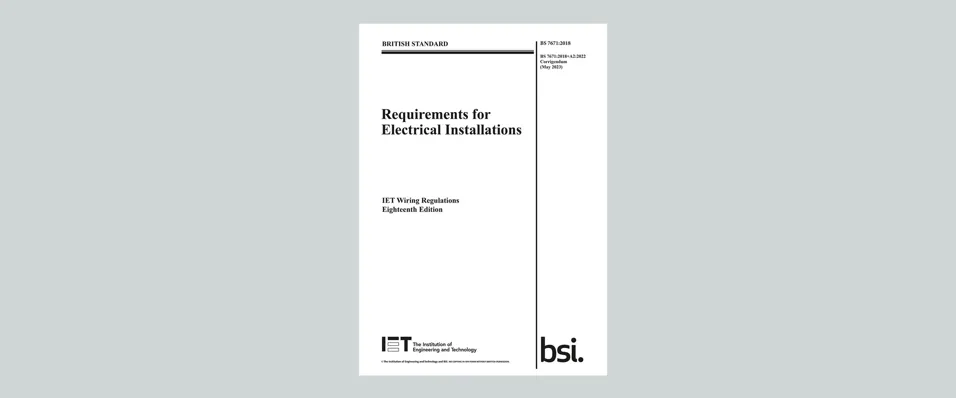
Corrigendum 2023 to BS 7671:2018+A2:2022
All British Standards are subject to review at least every five years. The outcome of the review will result in the standard either being confirmed for continued use, withdrawn or updated.
Information is received daily and sometimes it is necessary to make changes before the next planned Amendment to BS 7671.
This article provides an overview of the changes and the reasons for Corrigendum 2023 to BS 7671:2018+A2:2022.
What is a corrigendum?
BS 7671 is the largest British Standard in terms of the number of pages and could be said is one of the most complex to produce. Despite the hard work, heroic efforts and best intentions of many organisations and individuals, it is inevitable that some errors will be introduced.
The word ‘corrigendum’ is derived from the Latin verb corrigere, which means ‘to correct’. The plural form of ‘corrigendum’ is ‘corrigenda’.
Why is a corrigendum issued?
A corrigendum is issued where an error is inadvertently introduced during the drafting or production of a standard that could lead to incorrect or unsafe application of the standard. Trivial errors such as editorial issues are usually left uncorrected until the next amendment of BS 7671.
Has a corrigendum been issued previously for BS 7671?
This is not the first time a corrigendum has been published for BS 7671. For example, one was issued in May 2020 for corrections to Section 722 of BS 7671:2018+A2:2020 for electric vehicle charging installations. Another was also issued in January 2016 for corrections to various issues identified with BS 7671:2008+A3:2015. Updates can be downloaded for free from the updates to the 18th Edition page on the IET electrical website.
How do I obtain a copy of corrigendum 2023 to BS 7671:2018+A2:2022?
The Corrigendum 2023 to BS 7671:2018+A2:2022 will be available for free on the IET electrical website on the ‘updates to the 18th Edition’ page. It will be included in the IET’s digital platform - Digital subscriptions to BS 7671 and IET guidance (theiet.org) and also from BSI.
What are the changes in Corrigendum 2023 to BS 7671:2018+A2:2022?
Broadly speaking, the changes can be summarised in four main areas as below:
- Section 422 - Protected escape routes
- Section 443 - Overvoltage protection
- Section 701 - Birthing pools
- Section 710 - Protected escape routes in medical locations
The biggest change in terms of numbers of people affected and likely to impact most electricians relates to the requirements for overvoltage protection, specifically SPDs. The changes to protected escape routes are also likely to affect a large number of projects. Medical locations are a niche sector so the changes will probably impact fewer people, but that is not to say the issues highlighted in this area are of any less importance.
Section 422 - Protected escape routes
What is a protected escape route?
It is important to note that the fire strategy and fire engineering requirements are the responsibility of a fire engineer. It is not the job for an electrician to determine which areas are considered protected escape routes or not. Professional advice from a fire engineer should be sought.
The term ‘protected escape route’ is defined in BS 7671:2018+A2:2022 as below:
Protected escape route. A route enclosed with specified fire-resisting construction designated for escape to a place of safety in the event of an emergency (see also Escape route).
The term ‘protected escape route’ is an all-encompassing term used in Part B of the Building Regulations to cover a range of key terms, such as, ‘protected corridor’, ‘protected lobby’, ‘protected shaft’ and ‘protected stairway’.
Why has Regulation 422.2 been amended?
The publication of BS 7671:2018+A2:2022 introduced changes to Regulation 422.2 which affects protected escape routes. Effectively this prohibited the installation of cables and other electrical equipment in protected escape routes unless they were part of:
- an essential fire safety or related safety system
- general needs lighting
- socket-outlets provided for cleaning or maintenance
This creates difficulties for the construction industry, for example, take a typical multi-storey residential building. The route for services is through a building vertically through service risers to each floor and horizontally the common route for services to each flat is above the ceiling through the corridors.
What are the changes and implications for electrical designers?
It was decided to specifically state the exact type of protected escape route in which wiring systems are not permitted, such as ‘firefighting lobby, shaft or staircase of a protected escape route’. Following the corrigendum, the term ‘protected corridor’ is not included, therefore it is permitted to install wiring systems within a protected corridor.
However, it is not just a case of any wiring system will do, for example, PVC materials are not permitted as they produce toxic gases and vapours including hydrochloric acid, dense smoke and are flame propagating under fire conditions.
What are the requirements of Regulation 422.2.1 of BS 7671:2018+A2:2022?
The requirements of Regulation 422.2.1 of BS 7671:2018+A2:2022 specify types of wiring systems that can be installed in protected escape routes. For example, where cables and containment are used, they shall meet requirements for resistance to flame propagation and shall be of limited smoke protection.
The requirements of Regulation 422.2.1 of BS 7671:2018+A2:2022 have not changed in Corrigendum 2023. Previously, the requirements only applied to the services listed in the three indents which were for essential fire related safety systems, lighting or socket-outlets for maintenance purposes within the protected escape route. Whereas now it is permitted to install wiring systems within a protected corridor of a protected escape route, these requirements also apply to protected corridors.
In addition, the requirements of Chapter 527 of BS 7671:2018+A2:2022 relating to selection of wiring systems to minimise the spread of fire must be complied with.
Section 443 - Overvoltage protection
Why have the requirements for overvoltage protection been amended?
Following the introduction of the risk assessment method in BS 7671:2018, many comments were received on the DPC for BS 7671:2018+A2:2022 saying that the requirements for overvoltage protection were too complicated. The comments were reviewed by the committee responsible and a decision was made to remove the risk assessment to make the process simpler.
Subsequently, reports were received that the requirements for overvoltage protection were over prescriptive, particularly for additions and alterations to existing installations and in some cases, it prevented housing association rollouts of grade D smoke alarm systems in domestic (household) premises.
The requirements for BS 7671 apply to new installations and it is easy to think of a completely new installation, however, the requirements also apply to additions or alterations to existing installations. The requirements for SPDs effectively meant retrospective upgrade of the installation, which was seen to be over prescriptive and not beneficial for all installations.
The requirements of BS 7671 are not retrospective but installations to earlier editions to the IEE/IET Wiring Relations may be potentially dangerous depending on their age. This is confirmed in the note by the HSE in the introduction. It states ‘Installations to which BS 7671 is relevant may have been designed and installed in accordance with an earlier edition, now superseded but then current. That, in itself, would not mean that the installation would fail to comply with the Electricity at Work Regulations, 1989’.
The additional cost of SPDs for a new installation may be quite small in comparison to a whole new installation. However, for additions and alterations to an existing installation, such as the installation of grade D smoke alarm systems in domestic (household) premises, it can significantly increase the project costs, hence reduce the number of properties which can be installed with smoke alarms on the same budget.
Smoke alarms have been proven to save many lives over the years and it is important that the requirements of BS 7671 do not restrict the installation of such an important life saving device. Equally, it could be said that a life saving device, such as a smoke alarm, should have overvoltage protection where necessary and both sides of the argument have been heard and discussed at length.
What are the issues?
The issue mainly relates to the term ‘safety service’ in indent (ii) of Regulation 443.4.1 of BS 7671:2018+A2:2022, which states that overvoltage protection is required where an overvoltage could result in the failure of a safety service, as defined in Part 2.
One problem is that terms mean different things which depends on the standard you are reading. ‘Safety services’ is an all-encompassing term, depending on which document you read as it covers everything from smoke alarms and medical services to firefighters lifts.
The requirement in indent a) of Clause 443.4 of IEC 60364-4-443:2007+A1:2015 is to provide protection against transient overvoltage where the consequence caused by overvoltage affects human life. The terms ‘safety services’ and ‘medical care facilities’ are provided as examples. In some cases, examples can be helpful but in other situations they can lead to ambiguities and this is an example of that confusion, due to the wide reaching nature of the term ‘safety services’.
What is a risk of serious injury to, or loss of, human life?
At this point, it’s perhaps worth highlighting that the technical intent for overvoltage protection in BS 7671 is based on the BS EN 62305 series of standards for lightning protection systems. BS EN 62305-2:2012 does not use the term ‘safety services’, instead the term ‘internal systems’ is used, which are defined as ‘electrical and electronic systems within a structure’.
In the context of protection of transient overvoltages, the BS EN 62305 series describes risk to human life as ‘where failures of internal systems immediately endanger human life, this includes permanent injury’. This standard is referred to in the Note to Regulation 534.4.1.1 of BS 7671:2018+A2:2022. The examples of failure of internal systems cited in BS EN 62305-2:2012 are structures with the risk of explosion and hospitals with lifesaving equipment.
As the consequence of the failure of a safety service and serious injury to, or loss of, human life is practically the same thing when it comes to BS EN 62305 and failure of internal systems, it was decided to delete indent (ii) as it is already covered by indent (i), which covers serious injury to, or loss of, human life.
What is a safety service?
A safety service is defined in Part 2 of BS 7671:2018+A2:2022 as:
“Safety service. An electrical system for electrical equipment provided to protect or warn persons in the event of a hazard, or essential to their evacuation from a location.”
According to the definition of a safety service in Part 2 of BS 7671:2018+A2:2022, a smoke alarm system is a safety service. However, the failure of a smoke alarm does not immediately endanger human life. A smoke alarm, like any safety system is designed to be fail-safe, in that if there is an issue with the device it is designed to alert the user. The risk of overvoltages for domestic (household) premises is a consideration for economic loss and is not an immediate risk to human life.
Safety services are covered in Chapter 56 of BS 7671:2018+A2:2022. The requirements relate to the supply to safety services as opposed to the equipment itself. It could be said that the requirements for safety services were much clearer in the Fifteenth Edition of the IEE Wiring Regulations 1981.
The title of Regulation 313-2 in the Fifteenth Edition of the IEE Wiring Regulations was ‘Supplies for safety services and standby purposes’. It describes the person specifying the installation, the characteristics of the source and it being of adequate capacity and rating for the operation specified. It does not describe the connected electrical equipment.
313-2 Fifteenth Edition of the IEE Wiring Regulations 1981

Do smoke alarms need SPDs?
The first consideration is that where an installation is supplied by a low-voltage underground cable and a lightning protection system is not required or installed, there is minimal risk of overvoltages due to atmospheric origin. The risk of overvoltages due to switching in domestic (household) premises is unlikely. It is important to remember that part of engineering judgement is to balance the risk against the cost.
There are effectively two methods of overvoltage control. The first is protective control, where SPDs are installed, and then there is inherent control, where insulation coordination of equipment is relied on, referred to in; IEC 60664 Insulation coordination for equipment within low-voltage supply systems.
Products intended for the UK market must comply with the requirements of all applicable UK legislation. The Electrical Equipment (Safety) Regulations 2016 (EE(S)R) implements into UK law an EU Directive (2014/35/EU), commonly called the Low Voltage Directive. This applies to all electrical equipment that is designed or adapted for use between 50 V AC and 1,000 V AC, and 75 V DC and 1,500 V DC.
Mains operated smoke alarms to BS EN 14604:2005 are self-contained devices with backup power supplies intended to be connected directly to the mains supply, therefore, required to meet overvoltage category II (OVC II) requirements. The Ei electronics declaration of conformity for mains operated smoke alarms declares the applied standard EN 62368-1:2014/AC:2017 for compliance with the Low Voltage Directive 2014/35/EU, which states:
“For equipment to be supplied from the a.c. mains, the value of the mains transient voltage depends on the overvoltage category and the a.c. mains voltage and is given in Table 13. In general, clearances in equipment intended to be connected to the a.c. mains, shall be designed for overvoltage category II.”
Like all electrical products conforming to the (EE(S)R), smoke alarms are required to meet the requirements for OVC II, which means it has a rated impulse voltage withstand of 2.5 kV and inherent overvoltage control is sufficient, referred to in Regulation 443.6 of BS 7671:2018+A2:2022.
However, this may be different if there is a lightning protection system but that is covered in the BS EN 62305 series.
What is sensitive electronic equipment?
It is often said that computers and home electronics are ‘sensitive’ equipment and vulnerable to damage by overvoltages. However, these products are connected to the mains via a power supply unit which is required to meet the requirements for OVC II. Table 443.2 of BS 7671:2018+A2:2022 has therefore been amended to reflect the discussions. The examples of fire and security alarm systems have also been deleted from the note to Regulation 534.4.1.1 of BS 7671:2018+A2:2022.
Annex I, Table I.1 of IEC 62368-1:2020 Audio/video, information and communication technology equipment - Part 1: Safety requirements, states that home electronics and most information technology equipment (ITE) used in the building will be OVC II as shown below.
Table I.1 of BS EN IEC 62368-1:2020
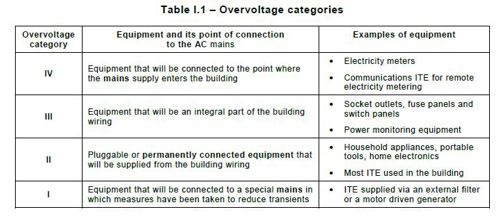
What if an installation has a lightning protection system?
Where an installation incorporates a lightning protection system, or where there is a risk of overvoltages transmitted by information and communications technology systems, this is outside the scope of BS 7671:2018+A2:2022 and the requirements of the BS EN 62305 series apply.
Can SPDs still be installed?
BS 7671 provides the minimum requirements for safety. There is nothing to prevent the installation of SPDs and it may provide some assurance against economic loss, however, the owner of the installation is best placed to make that decision. The default position is to install SPDs unless the owner of the installation declares that SPDs are not required due to any loss or damage being tolerable and they accept the risk of damage to equipment and any consequential loss, in such a case this must be recorded on the electrical installation certificate to prevent unforeseen liabilities at a later date.
Where a lightning protection system is installed or may be required, the BS EN 62305 series shall be used.
Section 701 - Birthing pools
Why has Section 710 of BS 7671:2018+A2:2022 been amended?
Including birthing pools within the scope of Section 701 had an unintended consequence of prohibiting the installation of socket-outlets to supply medical electrical equipment in these rooms. However, as the rooms containing birthing pools are designed for the purpose of delivering babies, in order to provide a room that met the functional needs of the clinicians and ultimately safety of the patients, it is necessary for socket-outlets to be installed closer than the requirements of Regulation 701.512.3 of BS 7671:2018+A2:2022.
After identifying this unintended consequence as a problem, birthing pools have been removed from the scope of Section 701 on the basis that specialist medical electrical equipment provides additional protection to the patient and that separating socket-outlets from the appropriate position close to the birthing pool presents an added risk to the occupants of the room.
The IET understands that it is intended to provide further guidance regarding the location of socket-outlets in industry specific guidance such as HTM 06-01 when it is next revised.
Section 710 - Protected escape routes in medical locations
Why have the requirements for protected escape routes in medical locations been amended?
The changes to Regulation 422.2 in BS 7671:2018+A2:2022 also affected medical locations.
Fire precautions and means of escape in hospitals differ from many other buildings mainly because of the use of progressive horizontal evacuation. Progressive horizontal evacuation avoids evacuating patients from the building as, in many cases, this can have a significant impact on the patient’s health and wellbeing.
As progressive horizontal evacuation is employed in the majority of hospitals, the fire strategy is such that most routes from patient areas are considered escape routes. These escape routes have structural fire protection with the fire strategy incorporating methods of keeping the occupants away from fire and smoke. This allows patients and staff to remain in relative safety and only move to another area of relative safety should the fire progress or not be contained.
The reference to protected escape routes within BS 7671:2018+A2:2022 impacted the design of electrical installations within healthcare premises.
Whilst in the original Note 2 in Regulation 422.2 of BS 7671:2018+A2:2022 it was acknowledged that hospitals may have special requirements, the details set out in Appendix 13 and Section 710, as published, did not provide enough information for designers to allow for the special requirements for healthcare premises that complied with fire safety guidance set out in the relevant HTMs.
Following the Corrigendum, Regulation 710.422.2.201 of BS 7671:2018+A2:2022 makes provision for cables or other electrical equipment to be installed in a protected escape route. This is subject to specific circumstances where they are part of a healthcare facility conforming to Health Technical Memoranda (HTM) and healthcare fire safety guidance. The particulars relating to the design and installation of the electrical installation in the protected escape route are required to be documented and recorded within the fire strategy for the building.
Regulation 710.422.2.201 of BS 7671:2018+A2:2022, also provides information relating to which specific guidance documents should be used in which of the devolved nations that the healthcare facility is located in, i.e. England, Scotland, Wales or Northern Ireland.
What is the content of Corrigendum 2023 to BS 7671:2018+A2:2022?
The amended text is shown below with red denoting changed text. The corrigendum can be downloaded here.
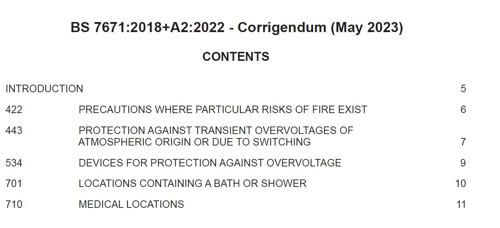
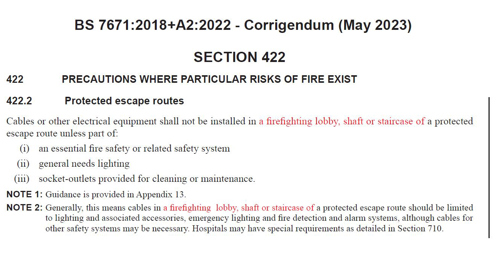
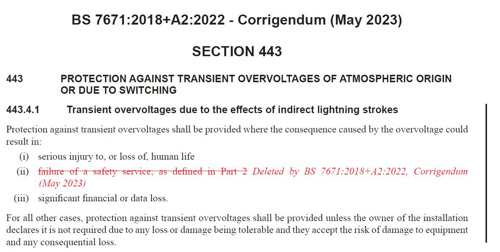
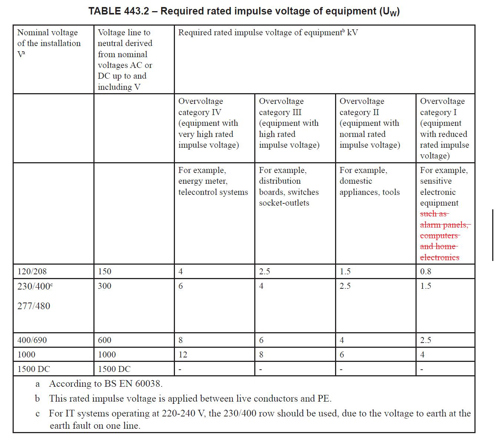
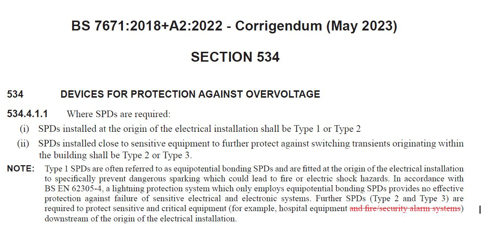
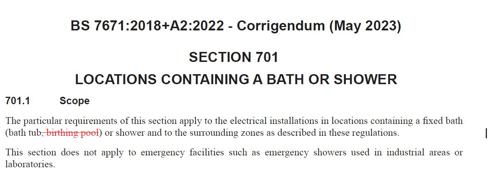
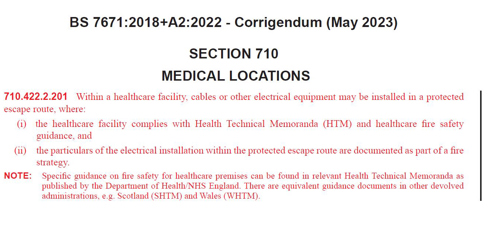
Acknowledgements
I would like to extend my sincere thanks to Paul Harris for providing his medical location expertise and input and I would also like to thank the following IET staff and volunteers for their valuable contributions to this article:
- Gary Gundry
- John Peckham
- Leon Markwell
- Mark Coles.
